#WJZ news
Text

#prodigy#prodigy email#1995#90s#1990s#90s tech#90s computers#WJZ news#VHS#VHSwave#vaporwave#synthwave#tracking#flashing#gif#my gifs#write a message
205 notes
·
View notes
Text
wjz in Baltimore has had some great anchors through the years but if you come to harm city these days be serious because we have lucifer morningstar now and I must say its very fitting.
1 note
·
View note
Text


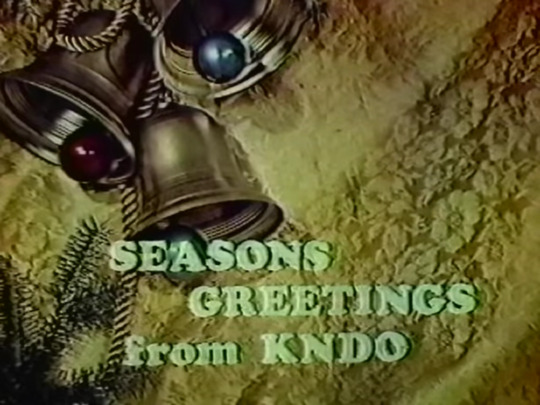




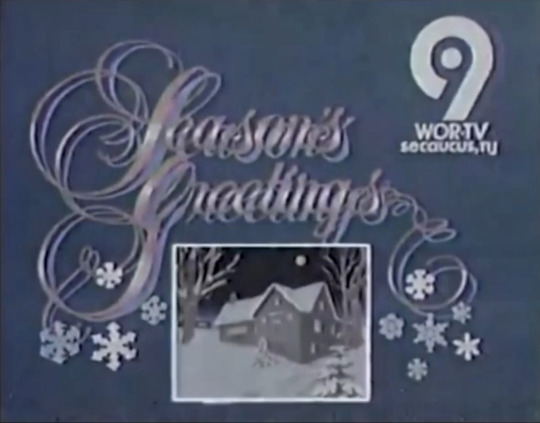

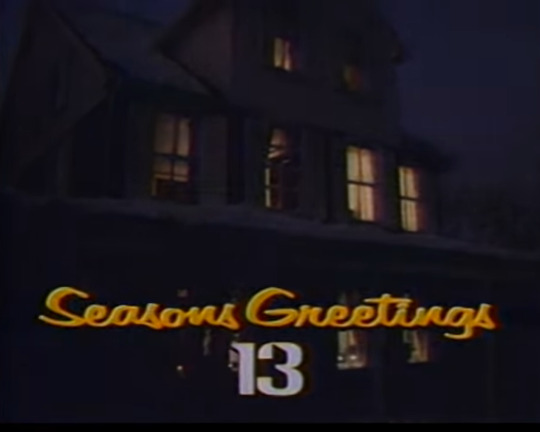
80′s/90′s Local Television Christmas/Happy Holidays/Season’s Greetings Station IDs/Bumpers Part 5
1. WPIX-TV, New York City, New York, 1986
2. KTVU-TV, Oakland/San Francisco, California, 1984
3. KNDO-TV, Yakima, Washington, 80's
4. WCAX-TV, Burlington, Vermont, 80's
5. KRON-TV, San Francisco, California, 1983
6. WTWO-TV, Terre Haute, Indiana, 1991
7. WCBS-TV, New York City, New York, 1985
8. WOR-TV, Secaucus, New Jersey, 1984
9. KTZZ-TV, Seattle, Washington, 1982
10. WJZ-TV, Baltimore, Maryland, 1982
Part 1 (x) Part 2 (x) Part 3 (x) Part 4 (x)
331 notes
·
View notes
Text

[Image Description: a photo of a TV showing a headline from WJZ that says "Aura Bora Introduces New Green Bean Casserole Flavored Seltzer Water". On the screen is a can of said seltzer water, and the closed captioning says "–No on the green bean –I don't want to taste that seltzer water that..." End I.D.]
Not a single word of this is encouraging
32 notes
·
View notes
Photo
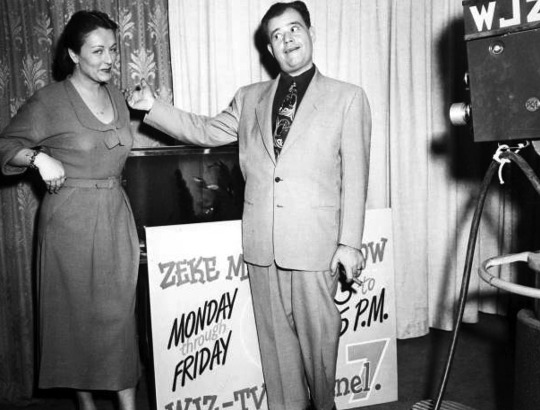
Here’s a real obscurity: “The Zeke Manners Show.”
Leo "Zeke" Manners (1911-2000) was a hillbilly singer, disc jockey, and composer of “The Pennsylvania Polka,” among other songs. According to his obituary in the New York Times (10/22/2000):
“After the war, he shuttled between the East and West Coasts. From 1950 to 1952, he was the host of one of television's earliest talk shows, on Channel 7, WJZ, which is now WABC. It was a two-hour free-for-all on which Eddie Cantor might pop up; Virginia Graham got her own start as a television host by serving as his sidekick.“
4 notes
·
View notes
Text
“LADIES AND GENTLEMEN… THE NICEST KIDS IN TOWN!”
IF I HAVE one regret in life, it's that I wasn't a Buddy Deaner. Sure, as a teenager I was a guest on this Baltimore show. I even won the twist contest with Mary Lou Raines (one of the queens of "The Buddy Deane Show") at a local country club.
But I was never a Deaner. Not a real one. Not one of the Committee members, the ones chosen to be on the show every day—the Baltimore version of the Mouseketeers, "the nicest kids in town," as they were billed. The guys who wore sport coats with belts in the back from Lee's of Broadway (ten percent discount for Committee members), pegged pants, pointy-toe shoes with the great buckles on the side and "drape" (greaser) haircuts that my parents would never allow. And the girl Deaners, God, "hair-hopppers" as we called them in my neighborhood, the ones with the Etta gowns, bouffant hairdos and cha-cha heels. These were the first role models I knew. The first stars I could identify with. Arguably the first TV celebrities in Baltimore.
I'm still a fan—a Deaner groupie. I even named some of the characters in my films after them. So you can't imagine how excited I was when I finally got a chance to interview these local legends twenty years later.
"The Buddy Deane Show" was a teenage dance party, on the air from 1957 to 1964. It was the top-rated local TV show in Baltimore and, for several years, the highest rated local TV program in the country. While the rest of the nation grew up on Dick Clark's "American Bandstand" (which was not even shown here because Channel I3 already had "Buddy Deane"), Baltimoreans, true to form, had their own eccentric version. Every rock 'n' roll star of the day (except Elvis) came to town to lip-sync and plug their records on the show: Buddy Holly, Bill Haley, Fats Domino, the Supremes, the Marvelettes, Annette Funicello, Frankie Avalon and Fabian, to name just a few.
You learned how to be a teenager from the show. Every day after school kids would run home, tune in and dance with the bedpost or refrigerator door as they watched. If you couldn't do the Buddy Deane Jitterbug (always identifiable by the girl's ever-so-subtle dip of her head each time she was twirled around), you were a social outcast. And because a new dance was introduced practically every week, you had to watch every day to keep up. It was maddening: the Mashed Potato, the Stroll, the Pony, the Waddle, the Locomotion, the Bug, the Handjive, the New Continental and, most important, the Madison, a complicated line dance that started here and later swept the country.
Although the show has been off the air for more than twenty years, a nearly fanatical cult of fans has managed to keep the memory alive. The producers of Diner wanted to include "Buddy Deane" footage in their film, but most of the shows were live and any tapes of this local period piece have been erased. Last spring five hundred people quickly snapped up the $23 tickets to the third Buddy Deane Reunion, held at a banquet hall in East Baltimore, to raise money for the Baltimore Burn Center. Buddy himself, the high priest, returned for the event. And more important, so did the Committee, still entering by a special door, still doing the dances from the period with utmost precision. I was totally star-struck and had as much fun that night as I did at the Cannes Film Festival. All on tacky Pulaski Highway.
IN THE BEGINNING there was Arlene. Arlene Kozak, Buddy's assistant and den mother to the Committee. Now a receptionist living in suburbia with her husband and two grown children, Arlene remains fiercely loyal, organizing the reunions and keeping notebooks filled with the updated addresses, married names and phone numbers of all "my kids."
She met Winston J. "Buddy" Deane in the fifties when she worked for a record wholesaler and he was the top-rated disc jockey on WITH — the only DJ in town who played rock 'n' roll for the kids. Joel Chaseman, also a DJ at WITH, became program manager of WJZ-TV when Westinghouse bought it in the mid-fifties. Chaseman had this idea for a dance party show, with Buddy as the disc jockey, and Buddy asked Arlene to go to work for him.
On the air "before Dick Clark debuted," the show "was a hit from the beginning," says Arlene today.
The Committee, initially recruited from local teen centers, was to act as hosts and dance with the guests. To be selected you had to bring a "character reference" letter from your pastor, priest or rabbi, qualify in a dance audition and show in an interview ("the Spotlight") that you had "personality." At first the Committee had a revolving membership, with no one serving longer than three months.
But something unforeseen happened: The home audience soon grew attached to some of these kids. So the rules were bent a little; the "big" ones, the ones with the fan mail, were allowed to stay.
And the whole concept of the Committee changed. The star system was born.
If you were a Buddy Deane Committee member, you were on TV six days a week for as many as three hours a day-enough media exposure to make Marshall McLuhan's head spin. The first big stars were Bobbi Burns and Freddy Oswinkle, according to Arlene, but "no matter how big anyone got, someone came along who was even bigger."
Joe Cash and Joan Teves became the show's first royalty.
Joanie, whose mother "wanted me to be a child star," hit the show in early 1957 at age thirteen (you had to be fourteen to be eligible, but many lied about their ages to qualify), followed a few months later by Joe, seventeen. Like many couples, Joe and Joan m* through the show and became "an item" for their fans. Many years later they married.
"I saw the show as a vehicle to make something of myself," remembers Joe. "I was aggressive. I wanted to get into the record business" —and years later he did.
Joe started working for Buddy as "teen assistant" and, along with Arlene, oversaw the Committee and enforced the strict rules.
You received demerits for almost anything: Chewing gum. Eating the refreshments (Ameche's Powerhouses, the premiere teenage hangout's forerunner of the Big Mac), which were for guests only.
Or dancing with other Committee members when you were supposed to be dancing with the guests (a very unpopular rule allowed this only every fourth dance). And if you dared to dance the obscene Bodie Green (the Dirty Boogie), you were immediately a goner.
"I got a little power-crazed," admits Joe. "I thought I was running the world, so they developed a Board, and the Committee began governing itself." Being elected to the Board became the ultimate status symbol. This Committee's committee, under the watchful eye of Arlene, chose new members, taught the dance steps and enforced the demerit system, which could result in suspension or expulsion.
Another royal Deaner couple who met on the air and later married was Gene Snyder and Linda Warehime. They are still referred to, good naturedly by some, as "the Ken and Barbie of the show." Gene, a member of "the first Committee, and I underline first," later became president of the Board. Linda reverently describes her Committee membership as "the best experience I ever had in my life." They later became members of the "Permanent Committee," the hall of fame that could come back to dance even after retiring. "That was our whole social life, being a Buddy Deaner," says Gene. "It was a family: Buddy was the father, Arlene was the mother."
Even today Gene and Linda are the quintessential Deaner couple, still socializing with many Committee members, very protective of the memory, and among the first to "lead a dance" at the emotion-packed reunions. "Once a Deaner, always a Deaner," as another so succinctly puts it.
The early "look" of the Committee was typically fifties. And although few will now admit to having been drapes, the hairstyles at first were DAs, Detroits and Waterfalls for the guys and ponytails and DAs for the girls, who wore full skirts with crinolins and three or four pairs of bobby socks. Joe remembers "a sport coat I bought for $s from somebody who got it when he got out of prison.
I was able after a while to afford some clothes from Lee's of Broad-way" (whose selection of belted coats and pegged pants made it the Saks Fifth Avenue of Deaners).
One of the first ponytail princesses was "Peanuts" (Sharon Goldman, debuting at fourteen in 1958, Forest Park High School Chicken Hop), who went on the show because Deaners were "folk heroes." She remembers Paul Anka singing "Put Your Head on My Shoulder" to her on camera as she did just that. She became so popular that she was written up in the nationwide Sixteen magazine.
"On the show you were either a drape or a square," explains Sharon. "I was a square. I guess Helen Crist was the first drapette: the DA, the ballet shoes, oogies [tulle scarves], eye shadow—eye-liner was big then—and pink lipstick."
Helen Crist. The best little jitterbugger in Baltimore. The first and maybe the biggest Buddy Deane queen of all. Debuting at a mere eleven years of age, taking three buses every day to get to the show, wearing that wonderful white DA (created by her hairdresser father) and causing the first real sensation. She was one of the chosen few who went to New York to learn how to demonstrate the Madison and was selected for the "exchange committee" that represented Baltimore's best on "American Bandstand." She was the only one of the biggies who refused to be on the Board ("They had power; a lot were disliked because of it").
Helen's fans flocked to see her at the Buddy Deane Record Hops (Committee members had to make such personal appearances and sign autographs). "I got all these letters from the Naval Academy," Helen remembers, "so I went there one day, and all the midshipmen were hanging out the windows. It was a real kick!" Her fame even brought an offer to join the circus. "This man approached me, telegrammed me, showed up at the show. He wanted me to go to a summer training session to be a trapeze artist. I wanted to go, but my parents wouldn't let me. I was really mad. I wanted to join the circus."
Two other ponytail princesses who went on to the Buddy Deane hall of fame were Evanne Robinson, the Committee member on the show the longest, and Kathy Schmink. Today they seem opposites.
Over lunch at the Thunderball Lounge, in East Baltimore, Kathy remembers, "I could never get used to signing autographs. Why?' I'd wonder." She wasn't even a fan of the show. "It was a fluke. My mother wanted me to go; she took me down to the tryouts. At first I was so shy I hid behind the Coke machines."
But Evanne "used to come right home and head for the TV. I had always studied dance, and I wanted to go on (the show]. I'm the biggest ham." Although she denies being conscious of the cam-era, she admits, "I did try to dance up front. I wasn't going to go on and not be seen." But even Evanne turned bashful on one show, when Buddy made a surprise announcement. "I was voted prettiest girl by this whole army base. I was so embarrassed. Buddy called me up before the cameras, and I wasn't dressed my best. The whole day on the show was devoted to me."
BEING A TEENAGE STAR in Baltimore had its drawbacks. "It was difficult with your peers," recalls Peanuts. "You weren't one of them anymore." Outsiders envied the fame, especially if they lost their steadies to Deaners, and many were put off by boys who loved to dance. "Everybody wanted to kick a Buddy Deaner's ass," says Gene, recalling thugs waiting to jump Deaners outside the studio.
"It was so painful. It was horrible," says Joe. "I used to get death threats on the show. I'd get letters saying, If you show up at this particular hop, you're gonna get your face pushed in?" And Evanne still shudders as she recalls, "Once I was in the cafeteria.
One girl yelled 'Buddy Deaner' and then threw her plate at me. My mother used to pick me up after school to make sure nobody hassled me."
The adoring fans could also be a hassle. "I must have had ten different phone numbers," says Helen, "and somehow it would get out. There were a lot of obscene phone calls."
And the rumors, God, the rumors. "They all thought all the girls were pregnant by Buddy Deane," remember several. "Once I was off the show for a while, and they said I had joined the nun-nery," says Helen, laughing. "It was even in the papers. It was hilarious."
Some of the rumors were fanned on purpose. Because "Buddy Deane's" competition was soap operas, the budding teenage romances were sometimes played up for the camera. "One time I was going with this guy, and he was dancing with this guest I didn't like," says Evanne. "Buddy noticed my eyes staring and said, 'Do the same eyes.' And the camera got it." Kathy went even further. "I was with this guy named Jeff. We faked a feud. I took off my steady ring and threw it down. We got more mail: 'Oh, please don't break up!' Somebody even sent us a miniature pair of boxing gloves. Then we made up on camera."
Romance was one thing; sex was another. Most Deaner girls wouldn't even "tongue-kiss," claims Arlene, remembering the ruckus caused by a Catholic priest when the Committee modeled strapless Etta gowns on TV. From then on, all bare shoulders were covered with a piece of net.
Other vices were likewise eschewed. If a guy had one beer, it was a big deal. Some do remember a handful of kids getting high on cough medicine. "Yeah, it was Cosenel," says Joe. "They would drive me nuts when they'd come in the door, and I'd say, 'Man, you're gone. You are out of here. You are history.' "
Although many parents and WJZ insisted that Committee members had to keep up their grades to stay on the show, the reality could be quite different. With the show beginning at 2:30 in some years, cutting out of school early was common.
"I'd hook and have to dance in the back so the teachers couldn't see me," says Helen. "I had to get up there on time. My heart would have broken in two if I couldn't have gone on." Finally Helen quit Mergenthaler (Mervo) trade school, at the height of her fame. "The school tried to throw me out before. I couldn't be bothered with education. I wanted to dance."
"We had a saying: "The show either makes you or breaks you,'" says Kathy. "Some kids on the show went a little nuts, with stars in their eyes; they thought they were going to go to Hollywood and be movie stars."
Yet Joe was a dropout when he went on the show and then, once famous, went back to finish. And according to Arlene, Buddy encouraged one popular Committee member (Buzzy Bennet) to teach himself to read so he could realize his dream of being a disc jockey. He eventually became one of the most respected programmers in the country and was even written up in Time magazine.
WITH THE 1960s came a whole new set of stars, some with names that seemed like gimmicks, but weren't: Concetta Comi, the popular sister team of Yetta and Gretta Kotik. And then there was teased hair, replacing the fifties drape with a Buddy Deane look that so pervaded Baltimore culture (especially in East and South Baltimore) that its effect is still seen in certain neighborhoods.
Some of the old Committee kept up with the times and made the transition with ease. Kathy switched to a great beehive that resembled a trash can sitting on top of her head ("I looked like I was taking off"). And Helen, Linda and Joanie all got out the rat-tail teasing combs.
Fran Nedeloff (debuting at fourteen in 1961, Mervo High School cha-cha) remembers the look: "Straight skirt to the knee, cardigan sweater buttoned up the back, cha-cha heels, lots of heavy black eyeliner, definitely Clearasil on the lips, white nail polish. We used to go stand in front of Read's Drugstore, and people would ask for our autograph."
Perhaps the highest bouffants of all belonged to the Committee member who was my personal favorite: Pixie (who died several years later from a drug overdose). "You could throw her down on the ground, and her hair would crack," recalls Gene. Pixie was barely five feet tall, but her hair sometimes added a good six to eight inches to her height.
But by far the most popular hairdo queen on "Buddy Deane" was a fourteen-year-old Pimlico Junior High School student named Mary Lou Raines. Mary Lou, the Annette Funicello of the show, was the talk of teenage Baltimore. Every week she had a different "do" —the Double Bubble, the Artichoke, the Airlift -each topped off by her special trademark, suggested by her mother, the bow.
"We really sprayed it," remembers Mary Lou today from her home in Pennsylvania. "The more hair spray, the better. After you sprayed it, you'd get toilet paper and blot it. Sometimes you'd wrap your hair at night. If you leaned on one side, the next day you'd just pick it out" into shape.
Mary Lou was the last of the Buddy Deane superstars, true hair-hopper royalty, the ultimate Committee member. "We have a tele-gram," Buddy would shout almost daily, "for Mary Lou to lead a dance," and the cameraman seemed to love her. "When that little red light came on, so did my smile," she says, laughing. At her appearances at the record hops, "kids would actually scream when you'd get out of the car: 'There's Mary Lou! Oh, my God, it's Evanne!' Autograph books, cameras, this is what they lived for. They sent cakes on my birthday. They'd stand outside my home. They just wanted to know if you were real. I was honored, touched by it all."
Mary Lou was aware that in some neighborhoods it was not cool to be a Buddy Deaner. "Oh sure, if you were Joe College (pre-preppie), you just didn't do 'The Deane Show.'" "Did you ever turn into a Joe College?" I ask innocently. "No!" she answers, with a conviction that gives me the chills.
But as more and more kids (even "Deane" fans) did turn Joe College, many of the Committee made the mistake of not keeping up with the times. Marie Fischer was the first "Joe" to become a Committee member-chosen simply because she was such a good dancer. As with the drapes and squares of the previous decade, she explains, "there were two classes of people then-Deaners and Joe College. The main thing was your hair was flat, the antithesis of Buddy Deane," she says, chuckling. "I was a misfit. Every day I'd come to the studio in knee-highs, and I'd have to take them off. You had to wear nylons. Before long I started getting lots of fan mail: I think you're neat. I'm Joe, too.' There was a change in the works."
Part of that change was the racial integration movement. "I had a lot of black friends at the time, so for me this was an awkward thing," says Marie. "To this day, I'm reluctant to tell some of my black friends I was on 'Buddy Deane' because they look at it as a terrible time."
Integration ended "The Buddy Deane Show." When the subject comes up today, most loyalists want to go off the record. But it went something like this: "Buddy Deane" was an exclusively white show. Once a month the show was all black; there was no black Committee. So the NAACP targeted the show for protests. Ironi-cally, "The Buddy Deane Show" introduced black music and artists into the lives of white Baltimore teenagers, many of whom learned to dance from black friends and listened to black radio. Buddy offered to have three or even four days a week all black, but that wasn't it. The protesters wanted the races to mix.
At frantic meetings of the Committee, many said, "My parents simply won't let me come if it's integrated," and WIZ realized it just couldn't be done. "It was the times," most remember. "This town just wasn't ready for that." There were threats and bomb scares; integrationists smuggled whites into the all-black shows to dance cheek to cheek on camera with blacks, and that was it. "The Buddy Deane Show" was over. Buddy wanted it to end happily, but WJZ angered Deaners when it tried to blame the ratings.
On the last day of the show, January 4, 1964, all the most popular Committee members through the years came back for one last appearance. "I remember it well," recalls Evanne. "Buddy said to me, 'Well, here's my little girl who's been with me the longest.' I hardly ever cried, but I just broke down on camera. I didn't mean to, because I never would have messed up the makeup."
IN 1985 THE COMMITTEE MEMBERs are for the most part happy and healthy, living in Baltimore, and still recognized on the street. "They kept their figures, look nice and are very kind people," says Marie from her lovely country home before taking off for the University of Maryland, where she attends law school.
Most are happily married with kids and maintain the same images they had on the show. "We are kind of like Ozzie and Harriet," says Gene Snyder as Linda nods in agreement. "I'm a typical middle-class housewife," says Peanuts, "Girl Scout leader, very active in my kid's school." Mary Lou is still a star. That she has an affluent life-style surprises no one on the Committee. In her home, near Allentown, Pennsylvania, she serves me a beautiful brunch, models her fur coats and poses with her Mercedes. "When I get depressed, I don't go to the psychiatrist; I go to the jeweler," she says.
Oddly enough, few of the Deaners I've talked to went on to show biz. Joe Cash has Jonas Cash Promotions ("my own promotional firm—we represent Warner Brothers, Columbia, Motown-eighty-five percent of the music you hear in this market")-and Active Industry Research (a "research firm-I'm chairman of the board"). Evanne and her brother run the John Brock Benson Dance Studios and have a line of dancers who appear at clubs all over the state. But most have settled down to a very straight life.
And none are bitter. Although the Committee was a valuable promotional tool for WJZ at the time, and belonging was a full-time job, no one (except teen assistants) was paid a penny. Even doing commercials was expected. Mary Lou laughs at the memory of doing a pimple medicine spot on camera. And who can forget those great ads for the plastic furniture slipcovers that opened with the kids jumping up and down on the sofa and a local announcer screaming, "Hey, kids! Get off that furniture!"? Or the Bob-a-Loop? Or Hartford Motor Coach Company? Or Snuggle Dolls? The Deaners didn't mind. As Marie puts it, "The rewards were so great emotionally that you didn't have to ask for a monetary award."
Many had difficulties dealing with the void when the show went off the air. Gene calls it "a big loss." "It was living in a fantasy world," says Helen, "and later on, growing up, it was a definite blow: reality." "I still have a whole box of fan mail," says Evanne. "If I'm ever depressed, sometimes I think, 'Well, this will make me feel better,' and I go down and dig in the box."
Holding onto the memories more than anyone is Arlene Kozak, who is by far the most loved by all the Committee members. (They gave her a diamond watch at the last reunion.) "Do you miss show biz?" I ask her. "Not show biz," Arlene answers, hesitating, "but the record biz, the people. Yes, I miss it very much. I don't think I'll ever get over missing it, if you want to know the truth."
Many of the Committee members' spouses faced an even bigger adjustment. In "mixed marriages" (with non-Deaners), many of the outsiders resented their spouses' pasts. "At twenty-one I married a professional football player," Helen remembers, "and he made me burn all the fan mail. I had trunks of it. He was mad because I was as popular as he was. He just didn't understand."
But some have dealt with the problems in good humor. When Mary Lou's husband gave me the long and complicated directions to their home on the phone, he ended with, "And there you will find, yes, Mary Lou Raines." He later confided that when he first started dating her, he had no idea of her early career. "Everywhere we went, people would say 'There's Mary Lou.' I wondered if she had just been released from the penitentiary."
THE BUDDY DEANE phenomenon is hardly dead. Each reunion (and a new one is in the works) seems bigger than the last. Deaners seem to come out of the woodwork, drawn by the memory of their stardom. Buddy returns on a pilgrimage from St. Charles, Arkansas, where he owns a hunting and fishing lodge and sometimes appears on TV, to spin the hits and announce multiplication dances, ladies® choice, or even, after a few drinks, the Limbo. Some of the really dedicated Committee members get tears in their eyes. Was it really twenty years ago? Could it be?
Why not do "The Deane Show" on Baltimore TV again? Just once. A special. The ultimate reunion. From all over the country, the Deaners could rise again, congregate at the bottom of Television Hill, and start Madison-ing their way ("You're looking good. A big strong line!") up the hill to that famous dance party set, the one that now houses a talk show. The "big garage-type door" they remember would open, and they'd all pile in, past George and "Mom," the Pinkerton guards who used to keep attendance, and crowd into Arlene's office to comb their hair, confide their problems and touch up their makeup. Buddy could take his seat beneath his famous Top 20 Board, and the tension would build. "Ten seconds to airtime. . . . three, two, one. Ladies and gentlemen. . . the nicest kids in town!"
John Waters (Crackpot: The Obsessions of John Waters, 1986)
youtube
0 notes
Text
💜♒️🥂#ArtIsAWeapon
HAPPY 70TH B'EARTHDAY QUEEN @oprah!

🖼: Shawn Michael Warren, 2023. On view at National Portrait Gallery, Smithsonian Institution.
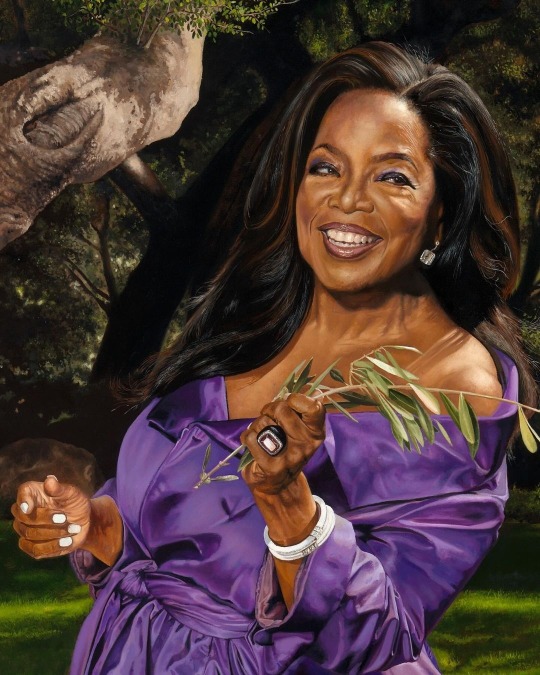
Reposted @nmaahc & @smithsoniannpg Born #OnThisDay in 1954 in Kosciusko, Mississippi, Oprah Winfrey came of age during an era of profound change in American society. As she watched TV coverage of the civil rights and women’s liberation movements of the 1960s and 1970s, Winfrey would be shaped by their sense of action-oriented possibilities for change.
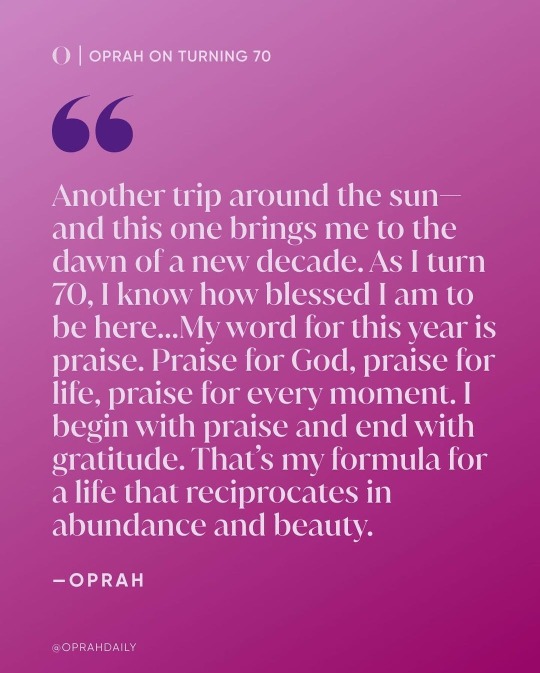
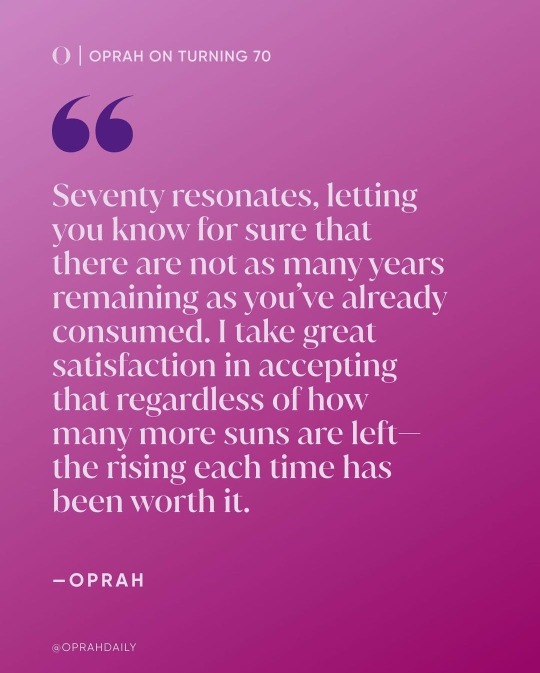
As a 17-year-old high school senior in Nashville, Winfrey began her career in broadcasting as a news reader for WVOL-AM’s radio station. She transferred to TV joining the Nashville’s WTVF where she became the youngest person and the first African American woman to anchor the news at the station. In 1976, Oprah Winfrey left Nashville to accept a job at WJZ-TV in Baltimore. She agreed to co-host a new daytime talk show, “People Are Talking.” While hosting, she discovered the talk show format was a better match for her personality, passions, and talents.
After 5 years of co-hosting “People Are Talking” in Baltimore, Winfrey learned that WLS-TV, the ABC affiliate in Chicago, was looking for a new host for its morning talk show. She auditioned for the job, and on January 1, 1984, she made her debut on “A.M. Chicago.” Winfrey was an instant hit on “A.M. Chicago,” and in 1985, the show was renamed “The Oprah Winfrey Show.”
For 25 years, “The Oprah Winfrey Show” dominated daytime TV. Watched by millions in over 150 countries, it was the highest-rated talk show in history. Winfrey used her unique life experiences to bring a wide range of topics into the living rooms of Americans everywhere that were previously unexplored on traditional daytime TV programs. #APeoplesJourney
#OprahWinfrey
0 notes
Text
Mysteries in the Sky: Hundreds in Maryland report UFO sightings as Congress, NASA investigate, push for transparency
CBS News
BY MIKE HELLGREN
UPDATED ON: OCTOBER 2, 2023 / 7:57 PM / CBS BALTIMORE
Almost two thousand people in Maryland have reported seeing something unexplained in the sky over the past two decades.
Commonly known as UFOs, the unknown objects have a new name and new attention from the government.
WJZ Investigator Mike Hellgren takes you inside the Mysteries in the Sky.
Read more…
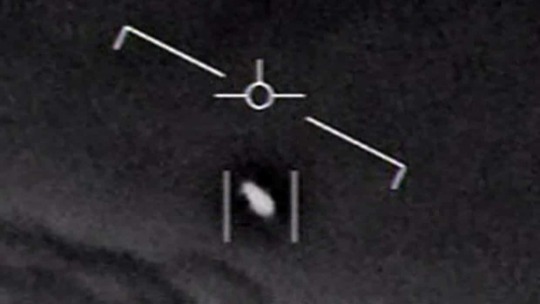
View On WordPress
0 notes
Text
Hot Wheels The Fast And Furious Nissan 240SX Silvia JDM S14 Kouki 1/5 Original
NISSAN JDM: Seller: rollmodelsdiecast (100.0% positive feedback)
Location: US
Condition: New
Price: 50.00 USD
Shipping cost: Free
Buy It Now https://www.ebay.com/itm/165695834904?hash=item26943dcb18%3Ag%3AnwAAAOSwaJli-Wjz&mkevt=1&mkcid=1&mkrid=711-53200-19255-0&campid=5338779479&customid=&toolid=10049&utm_source=dlvr.it&utm_medium=tumblr
0 notes
Text
Mother of 15-year-old Nykayla Strawder fighting for justice after daughter's death : Inside US
Mother of 15-year-old Nykayla Strawder fighting for justice after daughter’s death : Inside US
BALTIMORE — For the mother of 15-year-old Nykayla Strawder, the grief is unbearable.
“I can’t sleep. I have bags under my eyes,” Nykerah Strawder said in a new interview with WJZ. “No matter how many times I try to close my eyes, I see her.”
She is still demanding justice after police say a 9-year-old boy somehow gained access to a relative’s gun and shot Nykayla on her front porch.
“Put the…
View On WordPress
0 notes
Text
How To Track The James Webb Space Telescope's Progress To Scientific Operations - WJZ
How To Track The James Webb Space Telescope's Progress To Scientific Operations – WJZ
How To Track The James Webb Space Telescope’s Progress To Scientific Operations WJZ
The James Webb Space Telescope: Prepare for a New Way To See the Universe SciTechDaily
Webb’s mid-infrared spectroscopy will reveal molecules, elements Phys.org
Webb Space Telescope’s First Color Photos to be Unveiled on Live TV PetaPixel
First colour images from James Webb telescope to be released…

View On WordPress
0 notes
Photo
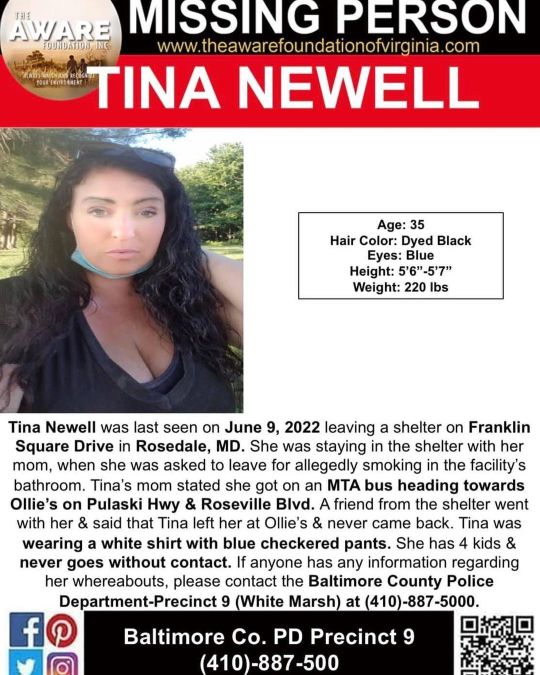
***MISSING*** ROSEDALE, MD The Baltimore Co. Police are seeking the public’s assistance in locating missing 35 year old Tina Newell. She was last seen on June 9, 2022 by her mom, leaving a shelter on Franklin Square Drive in Rosedale, MD. She was staying in the shelter with her mom, when she was asked to leave for allegedly smoking in the facility’s bathroom. Tina’s mom stated she got on an MTA bus headed to Ollie’s on Pulaski Hwy & Roseville Blvd. A friend from the shelter went with her on the bus & said that Tina left her at Ollie’s & never came back. She was wearing a white shirt & blue checkered pants. Tina is 5’6”-5’7”, 220 lbs with dyed black hair & blue eyes. She has 4 kids & never goes without contact. If anyone has any information regarding her whereabouts, please contact the Baltimore Co. Police Department-Precinct 9 (White Marsh) at (440)-887-5000. The White Marsh Police and Community Relations Council - PCRC Precinct 9, WBAL-TV 11 Baltimore, WBFF FOX 45, WJZ-TV | CBS Baltimore, WMAR-2 News Baltimore (at Maryland) https://www.instagram.com/p/Ce6-bzwv8E7/?igshid=NGJjMDIxMWI=
0 notes
Text
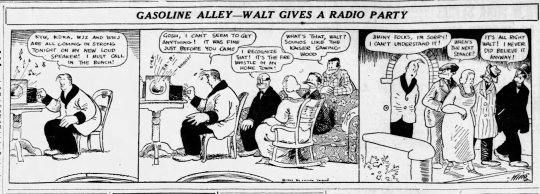
April 29, 1922
Gasoline Alley by Frank King: "Walt Gives a Radio Party"
The really interesting thing about this comic is Walt's speaker there. He's got that setup put together three years before the first moving-coil loudspeaker was patented in 1925 and five years before the Jensen Radio Manufacturing Co. began producing them. The first public use of a Magnavox loudspeaker was in 1919, so Walt must've fashioned his own based off of that. Guess that's what mechanic skills'll get ya - one of the first loudspeakers on historical record and a radio that gets signal from Chicago to Newark [all those stations are real!].
[ID: Walt sits happily in a wooden chair beside an end table, upon which he's sat his radio and what appears to be a rudimentary loudspeaker - a horn inlaid into a box. Music pipes out of it. /end]
Walt: KYW, KDKA, WJZ and WWJ are all coming in strong tonight on my new loud speaker! I must call in the bunch!
[ID: Walt sits at the radio, attempting to get a good signal for his assembled guests. Doc and Avery sit on the couch, Avery smoking a cigar. Bill leans over the back of it. Doc's wife sits on a rocking chair beside the couch. /end]
Walt: Gosh, I can't seem to get anything! It was fine just before you came.
Radio: ZING, GR-R, WHOOEE
Doc: I recognize that! It's the fire whistle in my home town!
Bill: What's that, Walt? Sounds like the Kaiser sawing wood.
[ID: Walt sees his guests out as they leave. /end]
Walt: Jiminy folks, I'm sorry! I can't understand it!
Bill: When's the next seance?
Doc: It's all right, Walt! I never did believe it anyway!
0 notes
Link
All Time Low on the news, 2006
#2006#Alex Gaskarth#Jack Barakat#Rian Dawson#Zack Merrick#all time low#news#wjz#video#embed code broken#put up or shut up
1 note
·
View note
Text
Hot Wheels The Fast And Furious Nissan 240SX Silvia JDM S14 Kouki 1/5 Original
NISSAN JDM: Seller: rollmodelsdiecast (100.0% positive feedback)
Location: US
Condition: New
Price: 50.00 USD
Shipping cost: Free
Buy It Now https://www.ebay.com/itm/165627711962?hash=item26902e51da%3Ag%3AnwAAAOSwaJli-Wjz&mkevt=1&mkcid=1&mkrid=711-53200-19255-0&campid=5338779479&customid=&toolid=10049&utm_source=dlvr.it&utm_medium=tumblr
0 notes
Text
BALTIMORE (WJZ) — Charging documents reveal gruesome new details in the case of a 28-year-old woman charged in the deaths of her two children.
A judge ordered that Jamerria Hall be held without bond as she waits for the next steps in her case. She has been charged with two counts of first-degree murder after her children were found dead Tuesday in their Southwest Baltimore apartment.
According to charging documents, Hall “drowned and strangled” her daughter six-year-old Da’neria Thomas.
According to the charging documents, when a maintenance worker went to check on their apartment after someone complained about an odor, Da’neria was found “lying face up in the bathtub with an apparent clothing object wrapped around her neck.”
According to the documents, her brother, eight-year-old Davin Thomas, was found in a sleeping bag and when a forensic examiner turned him over, a large knife was in the right side of his chest. A trash bag was around his face and neck.
Police said their bodies were decomposing.
Investigators said at least one person saw the mom and children last Thursday but then screams were heard coming from the apartment that same night and someone yelled, “Mommy, no!”
According to the documents, Hall spoke with her mother earlier this week and told her mother that the children were taken by their father, but the dad said he hadn’t seen the kids.
Hall had legal troubles in the past. In 2018, Hall was accused of setting fire to a home while her children were with her.
Hall once recorded a podcast where she appeared to reference the joys and struggles of motherhood.
“Y’all been driving me crazy, but I love y’all,” Hall said in a melodic tone. A young person responded by saying, “I love you too.”
Hall has been charged with two counts each of first-degree murder, first-degree assault and reckless endangerment.
Hall is being represented by the public defender’s office. Debbie Levy with the public defender’s office requested a competency evaluation and the judge granted the request. Hall is being held without bond.
12 notes
·
View notes